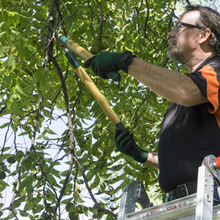Well, they may look like miniature petunias, and even be marketed that way, but calibrachoa are no longer in the same botanical genus as petunias. It's lucky for me that I was wrong, because if they weren't petunias then maybe I had another chance. After all, gardening is all about second chances and makeovers, right?
To get back to the calibrachoa (kal-ih-bruh-KOE-a), these attractive flowering sun-loving plants were discovered in South America in the 19th century, around the same time as petunias were discovered. Unlike petunias though, which were an instant hit with breeders and gardeners in Europe and the U.S., calibrachoa sort of just hung around. But they fixed calibrachoas to make them easier to grow and they taught me how to grow them better. And I'm here to teach you what I learned.
Calibrachoa are a terrific choice for containers, my favorite way to garden, as you know. One big problem with containers is keeping plants adequately hydrated, and as calibrachoa prefer to be slightly dry, they do well in containers. Calibrachoa tumble happily from hanging baskets and window boxes; they are now produced in many colors, from pinks, reds and oranges, to white, blue, purple, and nearly black.
Like petunias, calibrachoa have veining and color variation across the blossom, and flower color changes as the blooms age, producing a multi-colored effect. New hybrids are bred to take advantage of these traits, with latest hybrids displaying yummy colors like chocolate, wine or blueberry, and traits like double flowers or plants that are more compact or more trailing. "Superbells Tangerine Punch," pictured in the top photo right, for instance, a Proven Winner™ selection, is a vibrant orange-yellow with a darker eye in the center of each 1" flower. Some other selections are pictured below.
Calibrachoa Can-can orange photo Todd_Boland | C. Cabaret white improved photo Kell | C. Superbells blue photo palmbob | C. Callie rosestar photo Kell | |
 |  |  |  |
Calibrachoa should be trimmed when they look tired, maybe at the end of the hottest part of summer. They prefer to be on in the dry side side rather than soggy; that, I think, was one of my mistakes. They are prone to root rot in damp climates or if over-watered, so do be sure to plant in well-drained soil or a freely draining container. Like other herbaceous plants, trimming tired or leggy branches can encourage bushier growth. Do not trim more than a quarter to a third of the plant at one time.
Also called 'Million Bells,' calibrachoa are heavy feeders--they should be fertilized weekly with a well-balanced fertilizer. (I NEVER fertilized mine, clearly another fatal mistake.) They are good candidates for container plants because they do not mind occasional dryness. One of my sources advises to let the top layer of soil get dry before watering, while another admonished to keep evenly moist. Bearing in mind the plant's susceptibility to root-rot, don't let it dry out TOO much! Calibrachoa do not require dead-heading, although any time you like, feel free to trim a wayward stem with a sharp scissors and, of course, you may groom it by removing dead flowers but such grooming is not necessary for flower production. You may enjoy caressing the fuzzy, faintly aromatic foliage, which, unlike petunia's foliage, is not sticky.
In temperate zones, where it freezes in the winter, calibrachoa is grown as an annual. In fact, however, it is an evergreen perennial where the winters are mild. This may be why they are so beloved by California gardeners in PlantFiles. They are usually propagated from cuttings, which accounts for the slightly higher-than-average prices. (Seed-grown-plants would be much cheaper to produce.) However, these colorful, bright plants will deliver more-than-average sizzle!
Originally, calibrachoa were classified in the same genus as petunias, and while the two plants are close cousins in the Solanaceae family, they were given their own genus. To we who are interested in growing them, this is important because calibrachoa and petunias are closely enough related that the two can be crossed. The resulting hybrid plant is called "PETCHOA" or "CALITUNIA". These crosses are marketed as having flowers as big as petunias but being as easy-care as calibrachoas. The jury is still out, but stay tuned to Dave's Garden for the latest news in flower gardening!
 |

















